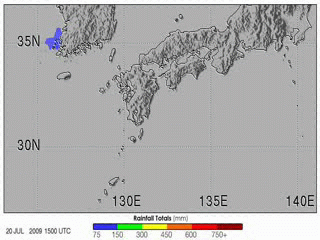Датотека:Heavy Rains in Southern Japan.gif
Heavy_Rains_in_Southern_Japan.gif (320 × 240 пиксела, величина датотеке: 8,35 MB, MIME тип: image/gif, петља, 268 кадрова, 8,0 с)
Историја датотеке
Кликните на датум/време да бисте видели тадашњу верзију датотеке.
| Датум/време | Минијатура | Димензије | Корисник | Коментар | |
|---|---|---|---|---|---|
| тренутна | 23:56, 31. јул 2009. |  | 320 × 240 (8,35 MB) | Originalwana | {{Information |Description={{en|1=The 2009 summer monsoon brought torrential rains to south western Japan in July. This animatin shows rainfall estimates for southern Japan and the surrounding region from July 20–27. The most prominent feature is a larg |
Употреба датотеке
Нема страница које користе ову датотеку.
Глобална употреба датотеке
Други викији који користе ову датотеку:
- Употреба на cs.wikipedia.org
- Употреба на en.wikipedia.org
- Употреба на fi.wikipedia.org
- Употреба на id.wikipedia.org
- Употреба на ja.wikipedia.org
- Употреба на ms.wikipedia.org
- Употреба на si.wikipedia.org
- Употреба на te.wikipedia.org
- Употреба на uk.wikipedia.org
- Употреба на vi.wikipedia.org
- Употреба на www.wikidata.org
- Употреба на zh.wikipedia.org



